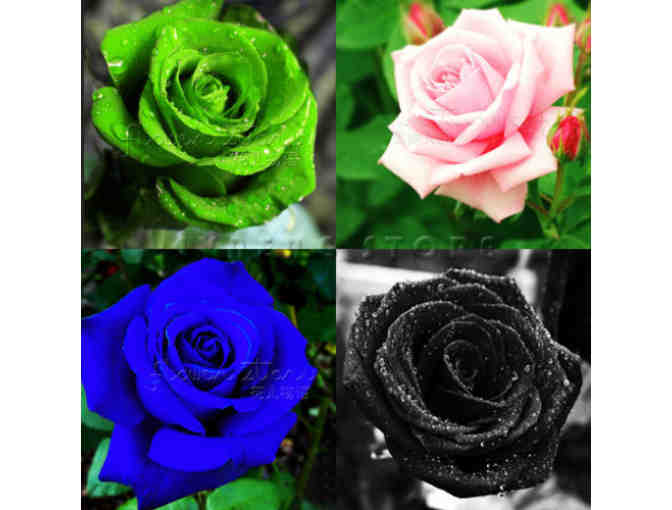Auction Ends: Jul 18, 2015 06:00 PM EDT
Lawn & Garden
10 Seeds Rose Seeds Include Pink Black White Red Purple Green Yellow Blue Color
- Item Number
- 110
- Estimated Value
- 200 USD
- Sold
- 50 USD to eddieboy
- Number of Bids
- 1 - Bid History
Item Description
Roses are best known for their flowers. Roses are popular garden shrubs, as flowering shrubs. They are also grown as cut flowers, as one of the most popular and commonly sold florists' flowers.
A few roses are grown for scented foliage (such as Rosa rubiginosa, ornamental thorns, Rosa sericea or their ornamental fruit Rosa moyesii).
Rose hips are occasionally made into jam, jelly, and marmalade, or are brewed for tea, primarily for their high vitamin C content. They are also pressed and filtered to make rose hip syrup. Rose hips are also used to produce Rose hip seed oil, which is used in skin products and some makeup products.
The leaves of most species are 5-15 centimetres long, pinnate, with (3-) 5-9 (-13) leaflets and basal stipules; the leaflets usually have a serrated margin, and often a few small prickles on the underside of the stem. The vast majority of roses are deciduous but a few (particularly in South east Asia) are evergreen or nearly so.
Symbolism
The rose has always been valued for its beauty and has a long history of symbolism. Roses are ancient symbols of love and beauty. 'Rose' means pink or red in a variety of languages (such as Romance languages, Greek, and Polish). The rose was sacred to a number of goddesses (including Isis and Aphrodite), and is often used as a symbol of the Virgin Mary. The ancient Greeks and Romans identified the rose with their goddesses of love referred to as Aphrodite and Venus. In Rome a wild rose would be placed on the door of a room where secret or confidential matters were discussed. The phrase sub rosa, or "under the rose", means to keep a secret — derived from this ancient Roman practice.
China
The China roses, based on Rosa chinensis, were cultivated in East Asia for centuries and finally reached Western Europe in the late 1700s. They are the parents of many of today's hybrid roses, and they brought a change to the form of the flower. Compared with the aforementioned European rose classes, the Chinese roses had less fragrant, smaller blooms carried over twiggier, more cold-sensitive shrubs. Yet they possessed the amazing ability to bloom repeatedly throughout the summer and into late autumn, unlike their European counterparts. The flowers of China roses were also notable for their tendency to "suntan," or darken over time — unlike the blooms of European roses, which tended to fade after opening. This made them highly desirable for hybridisation purposes in the early 1800s. According to Graham Stuart Thomas, China Roses are the class upon which modern roses are built.[7] Today's exhibition rose owes its form to the China genes, and the China Roses also brought slender buds which unfurl when opening. Tradition holds that four "stud China" roses ('Slater's Crimson China' (1792), 'Parsons' Pink China' (1793), and the Tea roses 'Hume's Blush Tea-scented China' (1809) and 'Parks' Yellow Tea-Scented China' (1824)) were brought to Europe in the late eighteenth and early nineteenth centuries; in fact there were rather more, at least five Chinas not counting the Teas having been imported.[8] This brought about the creation of the first classes of repeat-flowering Old Garden Roses, and later the Modern Garden Roses. Examples: 'Old Blush China', 'Mutabilis' (Butterfly Rose), 'Cramoisie Superieur'.
Item Special Note
Packaging Details
- Unit Type:
- lot (10 pieces/lot)
- Package Weight:
- 0.050kg (0.11lb.)
- Package Size:
- 20cm x 20cm x 10cm (7.87in x 7.87in x 3.94in)
American Football Association stores data...
Your support matters, so American Football Association would like to use your information to keep in touch about things that may matter to you. If you choose to hear from American Football Association, we may contact you in the future about our ongoing efforts.
Your privacy is important to us, so American Football Association will keep your personal data secure and American Football Association will not use it for marketing communications which you have not agreed to receive. At any time, you may withdraw consent by emailing Privacy@frontstream.com or by contacting our Privacy Officer. Please see our Privacy Policy found here PrivacyPolicy.

